The fall of Constantinople and the Byzantine Empire. Part of 2
Advanced Turkish detachments reached Constantinople on Monday, April 2, immediately after the feast of the Resurrection of Christ. The garrison of the city made a sortie. However, as more and more enemy forces arrived, the defenders returned to the city, destroying bridges over the ditches and closing the gates. Emperor Constantine also ordered to stretch the chain through the Golden Horn. One end of the chain was attached to the tower of St. Eugene is on the northeastern tip of the peninsula, and the other is on one of the towers of the Pera quarter (owned by the Genoese) on the northern shore of the Golden Horn. Wooden rafts supported the chain on the water. The chain prevented Turkish ships from entering the Golden Horn and landing troops under the northern walls of the capital. In addition, the entrance to the bay was protected by the forces of the Romance fleet.
The defense system of the Byzantine capital. It must be said that the Byzantine capital was located on the peninsula, which was formed by the Sea of Marmara and the Golden Horn Bay. The city blocks that overlooked the Marmara Sea and the bay coast were protected by city walls (although they were weaker than the fortifications that protected the city from the land). For the city walls with the 11 gate on the shores of the Sea of Marmara, the townspeople were relatively calm - the fortifications came almost directly to the sea, which prevented the landing of enemy troops, and the sea current here was strong and prevented the Turks from landing troops under the walls (plus shoals and reefs on which enemy ships could run into). Break into the bay, the vulnerable place of the city, interfered with the chain and fleet. In addition, to protect the wall (it had the 16 gate), near the Golden Horn, a moat was dug through a muddy coastal strip, Walls and a moat stretched from the bay and the Vlaherna quarter (north-western suburb of Constantinople) to the Studion area near the Sea of Marmara. The Vlaherna quarter was several times behind the general line and was covered by one line of walls; in addition, it was reinforced by the powerful structures of the imperial palace. Here the wall had two gates - Caligaria and Vlaherna. There was also a secret passage - Kerkoport, in the place where the fortifications of the quarter were connected to the wall of Theodosius (the Byzantine emperor of 5 in. Ne). The wall of Theodosius was double. The wall was covered by a deep ditch up to 18 meters wide. On the inner side of the moat there was a toothed parapet, between it and the first wall there was a passage to 12-15 meters (Perivolos). The outer wall was 7-8 meters high and had square towers spaced apart from each other at 45-100 meters. Beyond the outer wall was another passage 12-18 meters wide (Paratychion). Then there was an inner wall up to 12 meters in height and square or octagonal towers up to 18 meters in height. The towers were positioned so as to cover the gaps between the towers of the outer wall. The wall of Theodosius had several gates of general or only military purpose. The most vulnerable was considered the section of the walls near the river Lykos. Here, the terrain was lowered, and a river flowed into the city through a pipe (this section was called Mesohychion). In addition, there were other fortifications in the city itself — there were few separate quarters, palaces, etc. The Byzantines had few artillery, and besides, the towers and walls were not adapted for the installation of guns. With a strong garrison, such a nutlet was very difficult to take.
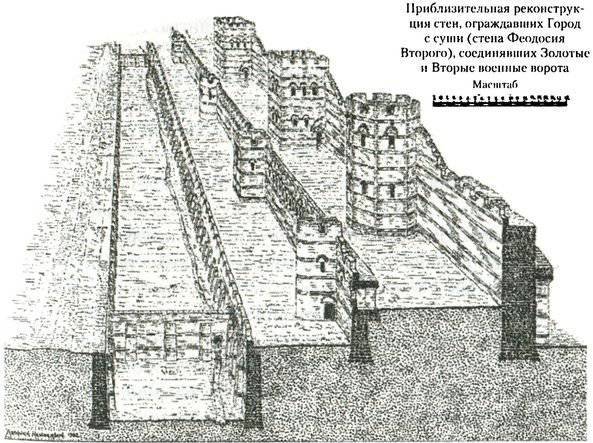
The wall in the cut. Three levels of defense are shown, the inner and outer walls and the moat.
The problem was that Constantine and his associates did not have the strength to cover all directions well and highlight strong reserves. I had to choose the most dangerous direction, and the rest to close the minimum forces. Yes, and significant reserves for the elimination of the enemy breakthrough was not. The Emperor and Giovanni Giustiniani Longo decided to concentrate forces on the defense of the external walls, because if the enemy had broken through the line of external fortifications, there was no way to knock out his forces. They had no troops to protect the inner wall. The emperor with his warriors occupied the most vulnerable area - Mesotihion. Giustiniani originally defended the Charisia Gate and the junction of Theodosius' walls with the fortifications of Vlacherna (Miriandrion), but then with his Genoese strengthened the emperor's detachment. Miriandrion remained to defend the Genoese, led by the Bocciardi brothers (Paolo, Antonio and Troilo). Part of the Venetian Venetians, led by Minotto, occupied the defense in Vlahernah in the area of the imperial palace. To the left of the forces of the emperor stood a detachment of the Genoese Cattaneo, further Greek compounds, led by a relative of the emperor Theophilus Paleolog. A unit led by Venetian Philip Contarini defended the site from Pigi to the Golden Gate. The Golden Gate was defended by the Genoese Manuele. Next, the plot to the sea defended detachment Dimitri Kantakuzin. The walls along the sea were defended by a small number of soldiers. The Studio area was entrusted to Giacomo Kantarini. The next section was guarded by the monks; in case of a threat, they should have called for help. Near them in the harbor of Eleutheria stood the Turkish prince Orhan with his entourage (he was a contender for the sultan's throne, so the successful defense of the city was in his interest). In the area of the hippodrome and the old imperial palace were located the Catalans Pere Julia. Cardinal Isidore, with 200 soldiers, held positions at the Acropolis. The shores of the Golden Horn were defended by the Genoese and Venetian sailors under the leadership of Gabriele Trevisano. Alvizo Diego commanded the Byzantine Navy. The city had two reserve units: the first with field artillery led by the first minister, Luca Notaras, was located in the Petra region; the second, headed by Nicephorus Palaeologus, stood by the church of Sts. Apostles.
The location of the Turkish forces. On April 5, the main Turkish forces led by Sultan Mehmed II appeared at the walls of Constantinople. April 6 Turkish troops occupied the position, the city was completely blocked. Part of the army led by Zaganos Pasha were sent to the north bank of the Golden Horn, where they isolated Peru. A pontoon bridge was moved across the marshland at the end of the bay so that there was a possibility of interaction with the main forces. Zaganos Pasha, on his own behalf and on behalf of the Sultan, guaranteed the protection and integrity of Peru (Galate) in the event that the residents of the quarter did not offer open resistance to the Turkish troops. Sultan has not planned to take Peru - this could cause the appearance of the Genoese fleet. In addition, apparently, an agreement was reached Turks with the Genoese and Venetian merchants, who supplied the city with food; shipments fell very soon, and famine began in Constantinople. Opposite Vlaherna there were regular troops from the European part of the Ottoman Empire, under the command of Karadzhi Pasha. He had at his disposal and heavy artillery. Batteries arranged to beat the junction of the walls of Theodosius with the fortifications of Vlaherna. Regular troops from Anatolia, led by Iskhak Pasha and Makhmud Pasha, were stationed from the southern bank of the Lykos River to the Sea of Marmara. The Sultan himself is located in the valley of the river Lykos opposite the most vulnerable place - Mesotikhiona. He had janissaries and other elite units at his disposal, as well as the most powerful tools of Urban. Behind the main forces were bashi-bazouks, ready to advance in any direction. The Turks on all fronts defended their positions from possible attacks, dug a ditch, and built a shaft with a paling. The Turkish fleet under the command of Baltoglu blocked Constantinople from the sea in order to prevent the supply of reinforcements, supplies and the flight of the Byzantines. In addition, he had the task to break into the Golden Horn.
It should be noted that in the army of the Sultan there were many Europeans from both the subordinate lands (Serbs, Bulgarians, Greeks, etc.) and volunteers. Thus, the Hungarian cannon master Urban, whose guns played an important role in the fall of Constantinople, himself offered Mehmed II his services. There was a European (Greek or Albanian) second vizier and head of the Janissaries Zaganos Pasha.
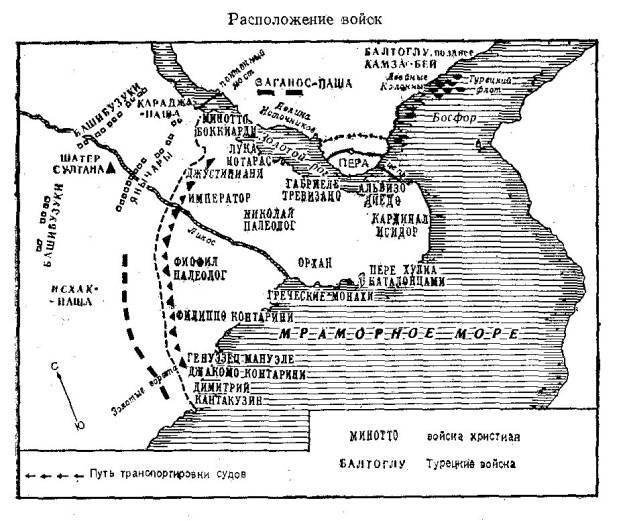
First fights
Mehmed II proposed to the emperor Constantine to surrender the city without a fight, promising him in return a number of guarantees - residence in one of the Greek provinces, lifelong immunity and material support. Residents were promised life and property preservation, and in case of refusal - death. Constantine and the Byzantines refused to capitulate. In principle, Sultan Mehmed II could do without an assault at all, a city blocked from all directions would have lasted at best for six months and then fell like a ripe apple. In the past, the Turks in the past took several strongly fortified cities of the Byzantines - those who were deprived of support from the outside and bringing food to the city eventually gave up. Moreover, it was useless to rely on the support of other Christian states: the nearest neighbors of Constantinople had already been conquered by the Ottomans, and Catholic Western Europe preferred to close their eyes to the problems of Orthodox “heretics” who had been dragging uni for so long, not wanting to obey Rome. But the young Turkish sultan was monstrously ambitious. Mehmed did not just want to take Constantinople. He wanted to capture him in battle and thereby immortalize his name for centuries, putting an end to more than a thousand-year-old Byzantine Empire, the “Second Rome”.
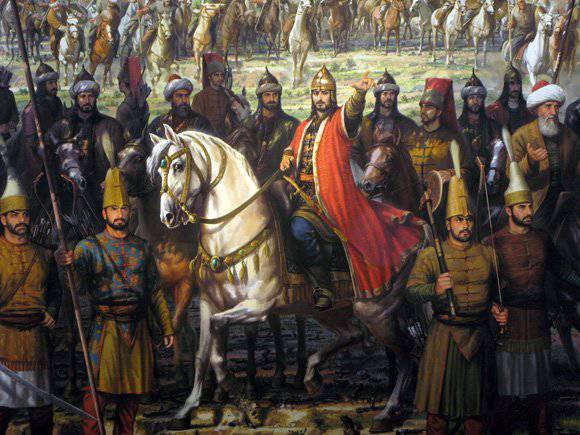
Already 6 April began a powerful shelling of the fortress walls. In the area of the Harisi Gate, the walls were badly damaged, and the 7s were destroyed. At night, the defenders sealed the gap. Sultan ordered to concentrate more guns, to fill up the moat, to be able to throw troops on the assault when the breaches appeared and to look for a place to dig under the walls. In addition, Baltoglu received an order to check the fortress barrage Bay. April 9 Turkish Navy tried to break into the bay, but did not have success. Baltoglu waited for the arrival of the Black Sea squadron.
While his orders were being carried out, the sultan took part of a select army and captured two Byzantine forts: one of them was in Ferapia on a hill off the coast of the Bosphorus, and the other in the village of Studios on the shores of the Sea of Marmara. Castle Therapia resisted for two days, then the walls were destroyed by artillery, most of the garrison died. 40 surrendered people were impaled. A smaller fort in Studios was demolished in a few hours, the surviving defenders 36 were impaled. The executions were carried out in such a way that they could be seen from the walls of Constantinople.
11 April, the Sultan returned to his headquarters, where the Turks concentrated all the heavy artillery against the wall above the river bed of Lykos. 12 April began bombing, which lasted 6 weeks. Among the guns were two giants created by the talent of Urbana. Among them is the Basil Cannon, it fired up to 2 km with cores weighing 500-590 kg. However, due to the difficulty of using the Basilica, no more than 7 shot once a day. The flaws of the gun were justified by the fact that the Basilica had tremendous destructive power. The besieged tried to weaken the damage from the shelling, hung large pieces of leather on the walls, bags of wool, but the benefits of these actions were few. A week later, the outer wall above the channel of Dikos was completely destroyed, and the ditch was filled up. People under the leadership of Giustiniani at night tried to seal the breaches with the help of wooden barriers and barrels of earth.
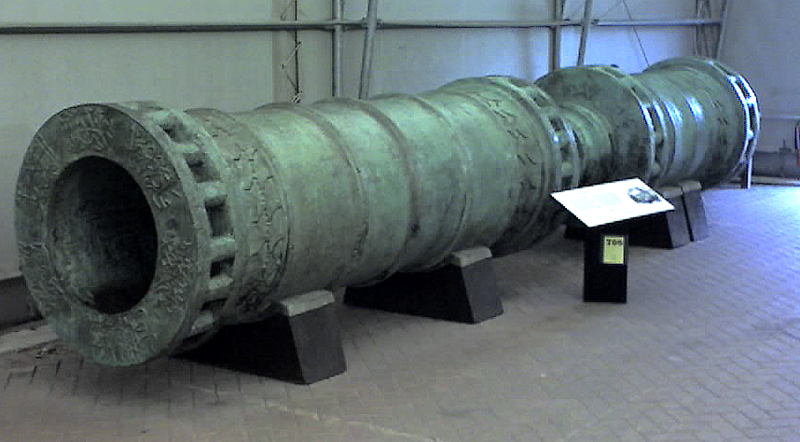
Dardanelles Cannon - an analogue of "Basilicas".
12 April Turks again tried to break into the bay. Turkish ships approached the barrier and attacked the romaic squadron. The ships of the Byzantines and their allies were better (for example, they surpassed Turkish ships with the height of the sides, which helped to repel the attempt of boarding), the captains were more experienced, they transferred the help of Lika Notaras to help them. The Byzantines launched a counterattack and attempted to surround the enemy ships, Baltoglu, saving the vanguard, withdrew his forces.
18 April, the Sultan threw troops to assault breaks at Lycos. Light infantry went into battle - archers, javelin throwers, heavy infantry units and janissaries. The storming men carried torches to set fire to wooden barriers, hooks to pull them away and assault ladders to overcome the remaining sections of the wall. The battle went on for four hours. The Turks in the narrow breach did not have a numerical advantage, and the soldiers of Giustiniani fought fiercely and skillfully. In addition, the superiority of the garrison in protective armaments was affected. Turks rolled back.
The victory of the Christians at sea. Turk breakthrough into the Golden Horn
Three Genoese ships hired by the Pope approached Constantinople from the south; they brought a load of food and weapons. On the way, the imperial ship joined them with the same cargo. The Dardanelles were not guarded - the entire Turkish fleet was near the city, it passed without problems. On the morning of April 20, the ships were seen from the city by Turkish observers. Sultan ordered them to drown or capture. Baltoglu put forward almost all of his forces, including boats and large transports (soldiers were loaded on them). The Turks were confident of victory, they had a huge numerical advantage in the courts and the people. Residents of the city with anxiety followed the unfolding events.
Baltoglu offered to surrender, but the ships continued to move. Advanced Turkish ships went to rapprochement. For almost an hour the galleys made their way into the environment, discarding the enemy. They had an advantage in armament and had high sides. Barrels of water had been prepared in advance and attempts to set fire to ships were quickly stopped. The Byzantine ship also had a so-called. "Greek fire". The crews were well prepared, the Genoese had good armor and responded to the danger in time. The ships almost came to the city when the wind died down and the current began to carry them away from Constantinople. It was like a group of bears fighting against a huge pack of wild dogs. Each Christian ship was surrounded by several dozen enemy large, medium and small ships. The Turks interfered with each other, went to the boarding, which their opponents successfully fought off. The fiercest battle was at the Byzantine cargo ship, it was stormed by 5 with tririds led by Baltoglu. Turks wave after wave tried to break through to the ship, but they were repeatedly thrown away. The captains of the Genoese ships, realizing that this could not last forever, decided to unite the ships. Skillfully maneuvering, they connected the ship's 4, it turned out a whole fortress. In the evening the wind rose, and the Christian ships were able to break through to the saving chain. The night came, and Baltoglu withdrew his forces. This victory instilled hope in the townspeople. The city received some ammunition, food and reinforcements (although almost half of the sailors were injured).
Sultan was enraged. In general, given the power of the army, the losses were minimal. But the prestige of the troops was undermined. A large fleet could not capture a handful of Christian courts, although there were all possibilities for this. Baltoglu was originally wanted to be executed, only the intercession of commanders saved him. The naval commander was deprived of all posts, the property was taken away in favor of the Janissaries. In addition, Baltoglu was punished by canine and expelled.
Sultan figured out how to master the Golden Horn. He decided to drag the ships over land over the Galata Hill, using special wagons and wooden rails for the purpose, like trams. In addition, they prepared the road in advance. The assembled carts with cast wheels were lowered into the water, brought under the hulls of Turkish vessels, and then with the help of bulls dragged ashore along with the ships. Bulls were harnessed to wagons and vessels were dragged along wooden rails past the Peru quarter from the Bosphorus through the hills to the northern shore of the Golden Horn. With each cart there was a special team that assisted on ascents and dangerous places. The Turks in this way were able to transfer about 70 ships. The operation was performed on April 22. The townspeople were shocked. The command undertook a series of meetings. The most decisive ones demanded an immediate attack by all the available ships on enemy ships or the landing of the landing force on the north bank of the Golden Horn in order to cut off enemy ships and burn them. In the end, we decided to attack the enemy squadron and burn it. But because of a number of delays (arguing among themselves, preparing ships, etc.), time was lost. The Turks transferred new guns and cover forces to the Source Valley. In addition, apparently, the Turks had agents in Pere, where they knew about the preparations for the attack and learned about the upcoming raid.
Early in the morning of April 28, the Byzantine ships moved to the Turkish squadron. But they were met with artillery fire, and then attacked. One galley was lost, several ships were damaged. The Turks were able to capture the 40 sailors, who sailed from the broken boats to the coast occupied by the Turks. They were beheaded in front of the whole city. In response, the townspeople brought 260 Turkish prisoners to the walls and executed 1204. The city was despondent. Turks oust from the Gulf failed. The townspeople remembered that it was through the walls near the Golden Horn in XNUMX that the crusaders were able to break into the city. It was necessary to identify people to protect these walls, which were previously in relative safety.
Hard May
Sultan did not use the victory for a new decisive assault from two directions. He continued the tactics of harnessing the garrison. Shelling continued. Every night, the townspeople closed up more and more breaks. The Turks installed cannons on rafts and now fired at the Blakhern quarter. The Turkish ships disturbed the Byzantine fleet, keeping it in suspense. There was a shortage of food. The emperor had to hold a new fundraising from churches and individuals, they bought food. A committee was established to distribute food. This relieved the tension, the rations were scarce, but everyone got their share. Livestock and grain stocks rapidly decreased. The Turks could take the city without assault, it was necessary only to wait.
In addition, quarrels between Venetians and Genoese took place in the city. Venetians blamed the Genoese for the April 28 crash. Only the intervention of the emperor made them outwardly reconcile. May 3 Venetian ship at night broke out of the blockade and went in search of the Venetian fleet. Constantine also offered to leave the city and go for help. Outside the city he could bring more benefits. Constantine refused, he feared that after his departure, there would be discord among the defenders.
5-6 May Turks conducted continuous shelling, apparently preparing for the assault. The Greeks expected attacks from two directions - against Mesotihione and across the bay with the help of the fleet. On the night of May 7, on the 8, the Turks repeated the attack against the breach near the Lykos River. The tactic was the same. A fierce battle lasted about three hours, the Turks were rejected. After this battle, the Venetians decided to transfer the ships to the Acropolis, unload all military equipment into the arsenal. The sailors went to the defense of the Blakhern quarter. On the night of 13 and 14 in May, the Turkish forces made another assault attempt, this time attacking the Blachernaire quarter. But here the fortifications suffered little, so the assault was repulsed without much effort.
14 May Sultan Mehmed II transferred guns from the heights of the Source Valley to the Vlahern wall and then to the main battery in the Lykos Valley. He decided to concentrate all the weapons here. 16, 17 and 21 in May, the Turkish Navy held a demonstration of forces at the barrier, but did not join the battle.
At the same time there was an underground war. The Turks carried out the first surveys in the first days of the siege, but there were no experienced people. Then Zaganos Pasha found the Serbian miners. Originally dug at the Harisian Gate, but the place was unfortunate. Then they began to dig under the Vlacherna at the Caligaria gate. 16 May besieged spotted underground work. First Minister Luke Notaras, he was responsible for extraordinary events, turned to Master Johannes Grant for help. He did kontrpodkop, the Greeks penetrated the enemy's tunnel and set fire to the supports. The roof collapsed, many Turks collapsed. 21 May Turks began to dig a new dig. The Greeks, led by Grant, were defeated upwards in an underground war: in some places they smoked the enemy with smoke, in other places they drowned the canals with water from tanks intended for a ditch. 23 May a mine was blown up by a Turkish mine and they blew up the enemy. After that, the Turks stopped digging digs. As a result, the defenders of Constantinople won up in an underground battle.
May 18 Sultan tried another tool - against the already heavily destroyed fortifications Mesotihiona Turks moved a huge wooden tower. In order not to be burned, it was covered with ox and camel skins, which were watered. The upper platform of the tower was located at the level of the outer wall of the city. On it were stairs for the transfer to the walls of the city. Towards nightfall, the Turks filled up and fortified the moat so that the tower could be moved to the wall. However, at night, an unknown hero was able to sneak into the tower with a keg of gunpowder and blow it up. By the morning, the Byzantines were able to close the gap and clear part of the moat.
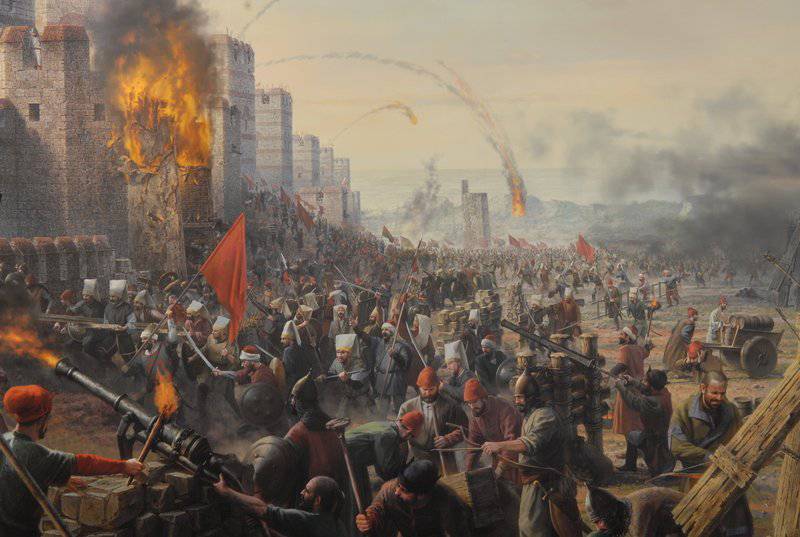
These were the last victories of the Greeks. 23 May, along with the joy of destroying all the enemy’s undergrounds, caused a strong psychological blow to the townspeople. A ship broke into the bay - it was a ship aimed at finding the Venetian fleet. The vessel went around all the islands in the Aegean Sea, but did not meet the ships of Venice. It finally became clear that there would be no help. It must be said that although the irretrievable losses of the garrison were insignificant, there were many wounded. Everyone was tired physically and mentally, hunger was coming. The garrison had to exert all the forces to close all new and new gaps.
To be continued ...
Information